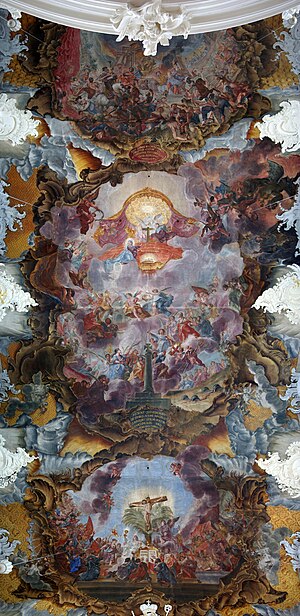Wikipedia:Picture of the day/January 2012
|
Featured picture tools: |
These featured pictures, as scheduled below, appeared as the picture of the day (POTD) on the English Wikipedia's Main Page in January 2012. Individual sections for each day on this page can be linked to with the day number as the anchor name (e.g. [[Wikipedia:Picture of the day/January 2012#1]] for January 1).
You can add an automatically updating POTD template to your user page using {{Pic of the day}} (version with blurb) or {{POTD}} (version without blurb). For instructions on how to make custom POTD layouts, see Wikipedia:Picture of the day.Purge server cache
January 1

|
|
An image of the Earth's cloud cover, which is the amount of sky obscured by clouds, based largely on observations from NASA's Moderate Resolution Imaging Spectroradiometer (MODIS) on board the Terra satellite. Clouds play multiple critical roles in the climate system. In particular, being bright objects in the visible part of sunlight, they efficiently reflect light to space and thus contribute to the cooling of the planet. Image: Marit Jentoft-Nilsen, NASA
Recently featured:
|
January 2

|
Two flesh-flies (Sarcophaga ruficornis species pictured) mating. The life cycle of the saprophagic flesh-fly larvae has been well researched and is very predictable. Different species prefer bodies in different states of decomposition, which allows forensic entomologists to extrapolate the time of death. Photo: Muhammad Mahdi Karim
Recently featured:
|
January 3
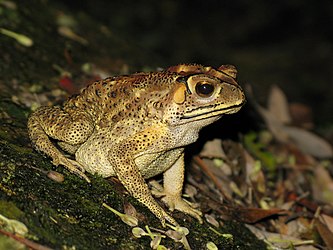
|
The Common Indian Toad (Duttaphrynus melanostictus) is native to South Asia. It grows to about 20 cm (8 in) long and breeds during monsoon season. These toads are often seen at night under street lamps especially during times when winged termites swarm. They have been noted to feed on a wide range of invertebrates, including scorpions. Photo: Lokionly
Recently featured:
|
January 4

|
|
Extermination of Evil is a set of five paintings believed to have been created in the 12th century, depicting traditional Asian deities banishing evil. The paintings are collectively listed as a National Treasure of Japan and held at the Nara National Museum. Clockwise, from top left: Sendan Kendatsuba, Shinchū, Bishamonten, Tenkeisei, and Shōki. Artist: Unknown
Recently featured:
|
January 5

|
The Sinai Agama (Pseudotrapelus sinaitus) is an agamid lizard native to northern and eastern Africa and the Middle East. It grows to about 25 cm (10 in) long, with the tail accounting for up to two thirds of the total length. It is active during daytime and feeds on insects and other arthropods and plants. During the breeding season, males become a striking blue colour to attract females. Photo: Ester Inbar
Recently featured:
|
January 6

|
|
A 2600 series car of the Chicago 'L' rapid transit system. The rolling stock of the 'L' consists of 1,190 rail cars (all permanently coupled into 595 married pairs) dating from 1969 to 2011. With 594 active cars out of a total of 600 built, the 2600 series is by far the most abundant in the 'L' rolling stock. Photo: Daniel Schwen
Recently featured:
|
January 7

|
The main circuits of the basal ganglia, a group of nuclei in the brains of vertebrates that act as a cohesive functional unit. Shown here are two coronal slices that have been superimposed to include the involved basal ganglia structures. + and − signs at the point of the arrows indicate respectively whether the pathway is excitatory or inhibitory in effect. Excitatory glutamatergic pathways
Inhibitory GABAergic pathways
Dopaminergic pathways that are excitatory on the direct pathway and inhibitory on the indirect pathway
Image: Mikael Häggström
Recently featured:
|
January 8

|
|
The Würzburg Residence is a UNESCO World Heritage Site located in Würzburg, southern Germany. It was commissioned by the Prince-Bishop of Würzburg Johann Philipp Franz von Schönborn and his brother Friedrich in 1720 and completed in 1744. The Venetian painter Giovanni Battista Tiepolo, assisted by his son, Domenico, painted frescoes in the building. Photo: Rainer Lippert
Recently featured:
|
January 9
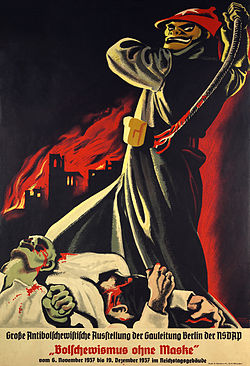
|
A 1937 anti-Bolshevik Nazi propaganda poster. A man with a skeleton face stands over bloody corpses, wielding a whip. His hat and clothing are Bolshevik in style. Before World War II, Nazi propaganda strategy, officially promulgated by the Ministry of Public Enlightenment and Propaganda, stressed several themes. Their goals were to create external enemies (countries that allegedly inflicted the Treaty of Versailles on Germany) and internal enemies. Translated caption: "Bolshevism without a mask – large anti-Bolshevik exhibition of the NSDAP Gauleitung Berlin from November 6 to December 19, 1937, in the Reichstag building". Poster: Herbert Agricola; Restoration: Jujutacular
Recently featured:
|
January 10

|
The Pine Grosbeak (Pinicola enucleator) is a large member of the true finch family. It is found in coniferous woods across Alaska, the western mountains of the United States, Canada, and in subarctic Fennoscandia and Siberia. Adult males (example shown here) have a rose-red head, back and rump, while females are olive-yellow on the head and rump and grey on the back and underparts. Photo: 72426950scott
Recently featured:
|
January 11

|
A recruitment poster for the United States Navy from 1918. Prior to the outbreak of World War I, military recruitment in the US was conducted primarily by individual states. Upon entering the war, however, the federal government took on an increased role, using five basic appeals to these campaigns: patriotism (the most prevalent theme), job/career/education, adventure/challenge, social status, and travel. Poster: Vojtech Preissig; Restoration: Lise Broer
Recently featured:
|
January 12

|
A United Nations vehicle patrols the streets of the Bel-Air neighborhood of Port-au-Prince in the aftermath of the catastrophic 2010 Haiti earthquake. The earthquake occurred at 16:53 local time (21:53 UTC) on Tuesday, 12 January 2010. An estimated three million people were affected by the earthquake, with an estimated 280,000 buildings severely damaged or destroyed. Photo: Marcello Casal Jr, Agência Brasil
Recently featured:
|
January 13

|
A "woolly bear" caterpillar belonging to the moth family Arctiidae. Many species in this large and diverse family (containing around 11,000 members) have "hairy" caterpillars and the family name is derived from the Greek word for "bear". Photo: Muhammad Mahdi Karim |
January 14
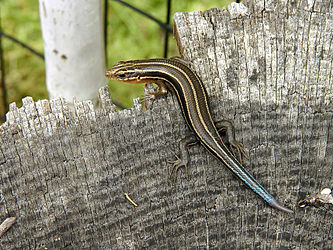
|
The American five-lined skink (Eumeces fasciatus) is one of the most common lizards in the eastern United States, as well as one of the five lizard species extant in Canada. It is a small to medium sized skink growing to about 12.5 to 21.5 cm (4.9 to 8.5 in). Juveniles (as seen here) are dark brown to black with five distinctive white to yellowish stripes running along the body and a bright blue tail. Photo: Thegreenj |
January 15

|
Edward Teller (1908–2003) was a Hungarian-American theoretical physicist, known colloquially as "the father of the hydrogen bomb". Teller was born in Budapest and emigrated to the United States in 1935. He was an early member of the Manhattan Project charged with developing the first atomic bombs. He was an early proponent of a fusion weapon, which most of his contemporaries believed was infeasible. In 1951, he and Polish mathematician Stanisław Ulam finally made the breakthrough which made the hydrogen bomb possible. Photo: US Department of Energy; Restoration: Greg L/PLW |
January 16

|
A single crystalline 1 cm3 cube and a crystalline fragment of molybdenum, the latter created by electron beam melting. Molybdenum is a silvery metal that has the sixth-highest melting point of any element. It readily forms hard, stable carbides, and for this reason it is often used in high-strength steel alloys. Photo: Alchemist-hp
Recently featured:
|
January 17

|
An illustrated version of Psalm 23, from The Sunday at Home, a 19th-century compendium of religious texts. Originally included in the Hebrew Bible, the psalm is popular among both Jews and Christians, is often alluded to in popular media and has been set to music. The most widely recognized version of the psalm in English today is undoubtedly the one shown here, drawn from the King James Bible. Image: Religious Tract Society; Restoration: Adam Cuerden
Recently featured:
|
January 18
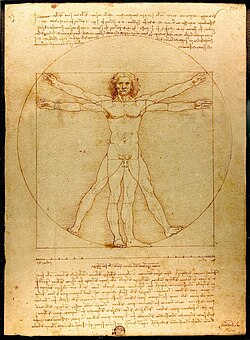
|
A photo of an original page from Leonardo da Vinci's journal, showing the world-renowned drawing known as the Vitruvian Man, created around the year 1492. The drawing and text are sometimes called the Canon of Proportions or, less often, Proportions of Man. Leonardo based his drawing on some hints at correlations of ideal human proportions with geometry in Book III of the treatise De architectura by the ancient Roman architect Vitruvius, thus its name. The accompanying notes are written in mirror writing and describe the drawing as a study of the proportions of the (male) human body as described by Vitruvius. Photo credit: Luc Viatour
Recently featured:
|
January 19

|
The Emperor shrimp (Periclimenes imperator) is a species of shrimp with a wide distribution across the Indo-Pacific. It lives commensally on a number of hosts, including sea cucumbers (Bohadschia argus shown here). Photo: Nick Hobgood
Recently featured:
|
January 20
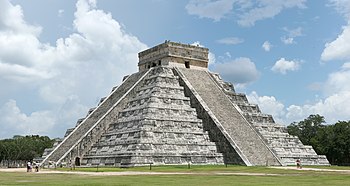
|
El Castillo, found in the Chichen Itza archaeological site, is a Mesoamerican step-pyramid that is one of the most recognized and widely visited pre-Columbian structures in Mexico. Built by the Maya, it served as a temple to Kukulkan, the Yucatec Maya Feathered Serpent deity. Photo: Daniel Schwen
Recently featured:
|
January 21
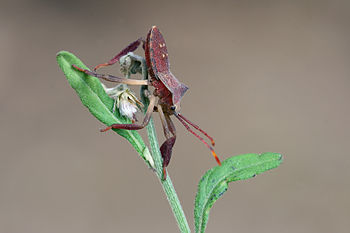
|
A nymph of an unidentified species from the Coreidae family, known colloquially in North America as "squash bugs", because some species, such as Anasa tristis, are pests of squash plants and other curcubits. There are over 1,800 coreid species found throughout the world, mostly inhabiting tropical and subtropical regions. Photo: Muhammad Mahdi Karim
Recently featured:
|
January 22

|
The Rainbow Lorikeet (Trichoglossus haematodus, nominate race T. h. haematodus shown) is a true parrot found throughout Australasia. It ranges from 25 to 30 cm (9.8 to 11.8 in) in size, and has a wingspan of about 17 cm (6.7 in). The plumage of all 12 subspecies is very bright, with the exact distribution of colours varying by subspecies. Photo: Benjamint444
Recently featured:
|
January 23
|
The fresco painted on the ceiling of the nave in Saint Paulin Church, a Baroque church in the city of Trier, Germany, named after Saint Paulinus. The current church building is the third to exist on this site and dates to 1734, but the church's history goes back to the 4th century. It was originally dedicated to the Theban Legion, a large group of men who were martyred for their Christian beliefs, twelve of whom are allegedly interred here. The fresco depicts scenes from the life of St Paulinus as well as the martyrdom of the legion. Artist: Christoph Thomas Scheffler;
Recently featured:
|
January 24

|
American actor Ernest Borgnine, when he was made an honorary chief petty officer of the United States Navy in October 2004. After being discharged from the navy after World War II and having no direction in his life, Borgnine began his acting career on the advice of his mother, who thought his personality was well-suited for the stage. This began a six-decade period mostly as a character actor on stage, film, and television. His most famous roles were as the lead in Marty, for which he won the Academy Award for Best Actor, the title role in McHale's Navy, and as a voice actor in the cartoon series SpongeBob SquarePants. Photo: Mark D. Faram, US Navy
Recently featured:
|
January 25
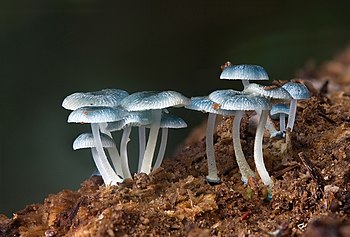
|
The pixie's parasol (Mycena interrupta) is a small detritivorous mushroom with a Gondwanan distribution pattern, being found in Australia, New Zealand, New Caledonia and Chile. It grows up to about 2 cm (1 in) in height, with the blue cap also growing up to 2 cm in diameter. It appears in small colonies on rotting, moist wood in rainforests and beech or eucalypt forests. Photo: JJ Harrison
Recently featured:
|
January 26
|
Panoramic view of the old town of Cologne, North Rhine-Westphalia, Germany, taken from Deutz, on the other side of the river Rhine at dusk. Visible from left to right are the former Lufthansa corporate headquarters, the Deutz Bridge, Great St. Martin Church, Cologne Cathedral, Museum Ludwig, the Cologne telecommunications tower Colonius, the Hohenzollern Bridge and the blue lights and reflections of the Cologne Musical Dome. Photo: Ahgee
Recently featured:
|
January 27

|
Grapefruit is the citrus fruit of the grapefruit tree (Citrus × paradisi), an 18th-century hybrid first bred in Barbados. The fruit is yellow-orange skinned and largely an oblate spheroid; it grows to about 10–15 cm (4–6 in) in diameter. The flesh is segmented and acidic, varying in color depending on the cultivars, which include white, pink and red pulps of varying sweetness (Ruby Red variety shown here). Photo: א (Aleph)
Recently featured:
|
January 28

|
Non-uniform rational B-spline is a mathematical model commonly used in computer graphics for generating and representing curves and surfaces for both analytic (described by mathematical formulas) and modeled shapes. Control points (shown as small spheres) influence the directions the surface takes. The square at the bottom sets the maximum width and length of the surface. Image: Greg L
Recently featured:
|
January 29

|
The first and most-visited of the four Elakala Falls located in Blackwater Falls State Park, West Virginia, US. The Blackwater River, named for its tannic acid-darkened water, flows over the falls as it makes its way into the rugged Blackwater Canyon. Photo: ForestWander Nature Photography
Recently featured:
|
January 30
|
Baalbek in Lebanon is famous for its exquisitely detailed yet monumentally scaled temple ruins of the Roman period, when, then known as Heliopolis, it was one of the largest sanctuaries in the Empire. It can be counted among the wonders of the ancient world, containing some of the largest and best preserved Roman ruins. Seen here is the Great Court of the temple complex. Photo: Guillaume Piolle
Recently featured:
|
January 31

|
A light microscope image of tissue paper. The tissue was illuminated with ultraviolet light making it glow blue due to natural autofluorescence, the same effect which makes paper glow with a black light. The tangled network of fibres are cellulose fibres which are derived from wood and make up all types of paper and cardboard. It is a combination of the properties of cellulose and additional optical brightening agents which makes the tissue glow. Photo: Richard Wheeler
Recently featured:
|
Picture of the day archives and future dates

